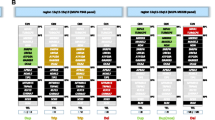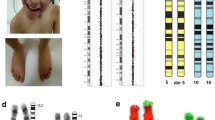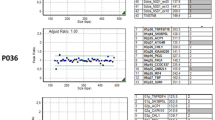Abstract
Intellectual disability (ID) and global development delay (GDD) are caused by genetic factors such as subtelomeric rearrangements (SR) in 25 % of patients. There are several assays currently available to detect SR, but subtelomeric fluorescence in situ hybridisation (Subt-FISH) and subtelomeric multiplex ligation-dependent probe amplification (Subt-MLPA) have been the most frequently used. However, the diagnostic yield of each technique has not been compared. We reviewed the results of SR screening over a ten-year period in Chilean patients with ID/GDD using Subt-FISH and/or Subt-MLPA, compared the diagnostic yield of both tools and reviewed the corresponding literature. A total of 383 cases were included in this study, of which 53.8 % were males. The overall diagnostic yield was 8.9 % between both methods, but Subt-MLPA showed a higher performance than Subt-FISH (p = 0.002). A total of 4,181 patients with ID/GDD have been studied worldwide with Subt-MLPA and other subtelomeric assays, and 244 (5.84 %) had a pathogenic SR. It is estimated that Subt-MLPA may detect 92.6 % of the total cases with SR. The capacity of detecting tandem duplication and other critical regions, as well as the use of two MLPA kits, may explain the higher performance of this tool over Subt-FISH. Therefore, we recommend the use of this subtelomeric method as a cost-effective way to study ID/GDD patients.


Similar content being viewed by others
References
Ahn JW, Ogilvie CM, Welch A, Thomas H, Madula R, Hills A, Donaghue C, Mann K (2007) Detection of subtelomere imbalance using MLPA: validation, development of an analysis protocol, and application in a diagnostic centre. BMC Med Genet 8:9
Boggula VR, Shukla A, Danda S, Hariharan SV, Nampoothiri S, Kumar R, Phadke SR (2014) Clinical utility of multiplex ligation-dependent probe amplification technique in identification of aetiology of unexplained mental retardation: a study in 203 Indian patients. Indian J Med Res 139:66–75
Christofolini DM, de Paula Ramos MA, Kulikowski LD, da Silva Bellucco FT, Belangero SI, Brunoni D, Melaragno MI (2010) Subtelomeric rearrangements and copy number variations in people with intellectual disabilities. J Intellect Disabil Res 54:938–942
Erjavec-Skerget A, Stangler-Herodez S, Zagorac A, Zagradisnik B, Kokalj-Vokac N (2006) Subtelomeric chromosome rearrangements in children with idiopathic mental retardation: applicability of three molecular-cytogenetic methods. Croat Med J 47:841–850
Jalal SM, Harwood AR, Sekhon GS, Pham Lorentz C, Ketterling RP, Babovic-Vuksanovic D, Meyer RG, Ensenauer R, Anderson MH Jr, Michels VV (2003) Utility of subtelomeric fluorescent DNA probes for detection of chromosome anomalies in 425 patients. Genet Med 5:28–34
Kirchhoff M, Gerdes T, Brunebjerg S, Bryndorf T (2005) Investigation of patients with mental retardation and dysmorphic features using comparative genomic hybridization and subtelomeric multiplex ligation dependent probe amplification. Am J Med Genet A 139:231–233
Knight SJ, Flint J (2000) Perfect endings: a review of subtelomeric probes and their use in clinical diagnosis. J Med Genet 37:401–409
Koolen DA, Nillesen WM, Versteeg MH, Merkx GF, Knoers NV, Kets M, Vermeer S, van Ravenswaaij CM, de Kovel CG, Brunner HG, Smeets D, de Vries BB, Sistermans EA (2004) Screening for subtelomeric rearrangements in 210 patients with unexplained mental retardation using multiplex ligation dependent probe amplification (MLPA). J Med Genet 41:892–899
Lam AC, Lam ST, Lai KK, Tong TM, Chau TC (2006) High rate of detection of subtelomeric aberration by using combined MLPA and subtelomeric FISH approach in patients with moderate to severe mental retardation. Clin Biochem 39:196–202
Madrigal I, Rodríguez-Revenga L, Costa L, Xunclà M, Sánchez A, Milà M (2010) A study of subtelomeric rearrangements in 300 patients with mental retardation and multiple congenital anomalies: their clinical and molecular characterisation. Rev Neurol 51:465–470
Medina A, Piñeros L, Arteaga C, Velasco H, Izquierdo A, Giraldo A, Espinosa E (2014) Multiplex ligation-dependent probe amplification to subtelomeric rearrangements in idiopathic intellectual disability in Colombia. Pediatr Neurol 50:250–254
Michelson DJ, Shevell MI, Sherr EH, Moeschler JB, Gropman AL, Ashwal S (2011) Evidence report: Genetic and metabolic testing on children with global developmental delay: report of the Quality Standards Subcommittee of the American Academy of Neurology and the Practice Committee of the Child Neurology Society. Neurology 77:1629–1635
Miller DT, Adam MP, Aradhya S, Biesecker LG, Brothman AR, Carter NP, Church DM, Crolla JA, Eichler EE, Epstein CJ, Faucett WA, Feuk L, Friedman JM, Hamosh A, Jackson L, Kaminsky EB, Kok K, Krantz ID, Kuhn RM, Lee C, Ostell JM, Rosenberg C, Scherer SW, Spinner NB, Stavropoulos DJ, Tepperberg JH, Thorland EC, Vermeesch JR, Waggoner DJ, Watson MS, Martin CL, Ledbetter DH (2010) Consensus statement: chromosomal microarray is a first-tier clinical diagnostic test for individuals with developmental disabilities or congenital anomalies. Am J Hum Genet 86:749–764
Monfort S, Orellana C, Oltra S, Roselló M, Guitart M, Martínez F (2006) Evaluation of MLPA for the detection of cryptic subtelomeric rearrangements. J Lab Clin Med 147:295–300
Mundhofir FE, Nillesen WM, Van Bon BW, Smeets D, Pfundt R, van de Ven-Schobers G, Ruiterkamp-Versteeg M, Winarni TI, Hamel BC, Yntema HG, Faradz SM (2013) Subtelomeric chromosomal rearrangements in a large cohort of unexplained intellectually disabled individuals in Indonesia: A clinical and molecular study. Indian J Hum Genet 19:171–178
Newman S, Hermetz KE, Weckselblatt B, Rudd MK (2015) Next-generation sequencing of duplication CNVs reveals that most are tandem and some create fusion genes at breakpoints. Am J Hum Genet 96:208–220
Northrop EL, Ren H, Bruno DL, McGhie JD, Coffa J, Schouten J, Choo KH, Slater HR (2005) Detection of cryptic subtelomeric chromosome abnormalities and identification of anonymous chromatin using a quantitative multiplex ligation-dependent probe amplification (MLPA) assay. Hum Mutat 26:477–486
Palomares M, Delicado A, Lapunzina P, Arjona D, Amiñoso C, Arcas J, Martinez Bermejo A, Fernández L, López Pajares I (2006) MLPA vs multiprobe FISH: comparison of two methods for the screening of subtelomeric rearrangements in 50 patients with idiopathic mental retardation. Clin Genet 69:228–233
Rafati M, Ghadirzadeh MR, Heshmati Y, Adibi H, Keihanidoust Z, Eshraghian MR, Dastan J, Hoseini A, Purhoseini M, Ghaffari SR (2012) “Familial” versus “sporadic” intellectual disability: contribution of subtelomeric rearrangements. Mol Cytogenet 5:4
Ravnan JB, Tepperberg JH, Papenhausen P, Lamb AN, Hedrick J, Eash D, Ledbetter DH, Martin CL (2006) Subtelomere FISH analysis of 11 688 cases: an evaluation of the frequency and pattern of subtelomere rearrangements in individuals with developmental disabilities. J Med Genet 43:478–489
Rooms L, Reyniers E, van Luijk R, Scheers S, Wauters J, Ceulemans B, Van Den Ende J, Van Bever Y, Kooy RF (2004) Subtelomeric deletions detected in patients with idiopathic mental retardation using multiplex ligation-dependent probe amplification (MLPA). Hum Mutat 23:17–21
Rooms L, Reyniers E, Kooy RF (2005) Subtelomeric rearrangements in the mentally retarded: a comparison of detection methods. Hum Mutat 25:513–524
Rooms L, Reyniers E, Wuyts W, Storm K, van Luijk R, Scheers S, Wauters J, van den Ende J, Biervliet M, Eyskens F, van Goethem G, Laridon A, Ceulemans B, Courtens W, Kooy RF (2006) Multiplex ligation-dependent probe amplification to detect subtelomeric rearrangements in routine diagnostics. Clin Genet 69:58–64
Schouten JP, McElgunn CJ, Waaijer R, Zwijnenburg D, Diepvens F, Pals G (2002) Relative quantification of 40 nucleic acid sequences by multiplex ligation-dependent probe amplification. Nucleic Acids Res 30:e57
South ST (2011) Chromosomal structural rearrangements: detection and elucidation of mechanisms using cytogenomic technologies. Clin Lab Med 31:513–524
Srivastava AK, Schwartz CE (2014) Intellectual disability and autism spectrum disorders: causal genes and molecular mechanisms. Neurosci Biobehav Rev 46:161–174
Stegmann AP, Jonker LM, Engelen JJ (2008) Prospective screening of patients with unexplained mental retardation using subtelomeric MLPA strongly increases the detection rate of cryptic unbalanced chromosomal rearrangements. Eur J Med Genet 51:93–105
Stoeva RE, Grozdanova LI, Vermeesch JR, Kirchhoff M, Fryns JP, Ivanov IS, Patcheva IH, Dimitrov BI, Krastev TB, Linev AJ, Stefanova MT (2008) Clinical and molecular-cytogenetic studies of cryptic chromosome aberrations in individuals with idiopathic mental retardation and multiple congenital malformations. Folia Med (Plovdiv) 50:55–62
Verdú Pérez A, García Murillo PL, García Campos O, López Grondona F, Arriola Pereda G, Alcaraz Rousselet MA, Vicente Lago Y, Suela J (2011) Subtelomeric rearrangements in cryptogenic mental retardation. An Pediatr (Barc) 75:365–371
Wu Y, Ji T, Wang J, Xiao J, Wang H, Li J, Gao Z, Yang Y, Cai B, Wang L, Zhou Z, Tian L, Wang X, Zhong N, Qin J, Wu X, Jiang Y (2010) Submicroscopic subtelomeric aberrations in Chinese patients with unexplained developmental delay/mental retardation. BMC Med Genet 11:72
Conflict of interest
None.
Author information
Authors and Affiliations
Corresponding author
Additional information
Communicated by: Michal Witt
Lorena Santa María and Víctor Faundes contributed equally to this work.
Rights and permissions
About this article
Cite this article
Santa María, L., Faundes, V., Curotto, B. et al. Comparison of two subtelomeric assays for the screening of chromosomal rearrangements: analysis of 383 patients, literature review and further recommendations. J Appl Genetics 57, 63–69 (2016). https://doi.org/10.1007/s13353-015-0295-4
Received:
Revised:
Accepted:
Published:
Issue Date:
DOI: https://doi.org/10.1007/s13353-015-0295-4




